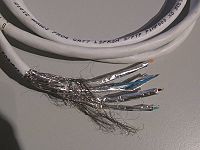
Category 7 cable
Encyclopedia

ISO/IEC 11801
International standard ISO/IEC 11801 specifies general-purpose telecommunication cabling systems that are suitable for a wide range of applications . It covers both balanced copper cabling and optical fibre cabling...
:2002 category 7/class F), is a cable standard for Ethernet
Ethernet
Ethernet is a family of computer networking technologies for local area networks commercially introduced in 1980. Standardized in IEEE 802.3, Ethernet has largely replaced competing wired LAN technologies....
and other interconnect technologies that can be made to be backward compatible with Cat 5 and Cat 6. Cat 7 features even more strict specifications for crosstalk and system noise than Cat 6. To achieve this, shielding
Shielded cable
A shielded or screened cable is an electrical cable of one or more insulated conductors enclosed by a common conductive layer. The shield may be composed of braided strands of copper , a non-braided spiral winding of copper tape, or a layer of conducting polymer. Usually, this shield is covered...
has been added for individual wire pairs and the cable as a whole. Besides the foil shield, the twisting of the pairs and number of turns per inch causes RF shielding and protects from crosstalk. Category 7 is recognized for all the country organizations members of ISO.
The Cat 7 cable standard has been created to allow 10 Gigabit Ethernet
10 Gigabit Ethernet
The 10 gigabit Ethernet computer networking standard was first published in 2002. It defines a version of Ethernet with a nominal data rate of 10 Gbit/s , ten times faster than gigabit Ethernet.10 gigabit Ethernet defines only full duplex point to point links which are generally connected by...
over 100 m of copper
Copper
Copper is a chemical element with the symbol Cu and atomic number 29. It is a ductile metal with very high thermal and electrical conductivity. Pure copper is soft and malleable; an exposed surface has a reddish-orange tarnish...
cabling
(also, 10 Gbit/s Ethernet now is typically run on Cat 6a
Category 6 cable
Category 6 cable, commonly referred to as Cat 6, is a cable standard for Gigabit Ethernet and other network physical layers that is backward compatible with the Category 5/5e and Category 3 cable standards. Compared with Cat 5 and Cat 5e, Cat 6 features more stringent specifications for crosstalk...
). The cable contains four twisted copper wire pairs, just like the earlier standards. Cat 7 can be terminated either with 8P8C compatible GG45
GG45
The GG45 is a connector for high-speed Category 7 cable LAN cabling developed by Nexans.The cabling system was standardized in 2001 as IEC 60603-7-7, and then selected as a worldwide Category 7 cabling...
electrical connectors which incorporate the 8P8C standard or with TERA
TERA
TERA is a shielded twisted pair connector for use with Category 7 twisted-pair data cables, developed by The Siemon Company and standardized in 2003 by International Electrotechnical Commission 61076-3-104....
connectors. When combined with GG45 or TERA connectors, Cat 7 cable is rated for transmission frequencies of up to 600 MHz.
, all manufacturers of active equipment have chosen to support the 8P8C for their 10 Gigabit Ethernet
10 Gigabit Ethernet
The 10 gigabit Ethernet computer networking standard was first published in 2002. It defines a version of Ethernet with a nominal data rate of 10 Gbit/s , ten times faster than gigabit Ethernet.10 gigabit Ethernet defines only full duplex point to point links which are generally connected by...
products on copper, and not the GG45 or TERA in order to function on Cat 6a. Due to lack of support for the 8P8C connector, Category 7 is not recognized in TIA/EIA-568
TIA/EIA-568
TIA/EIA-568 is a set of three telecommunications standards from the Telecommunications Industry Association, a 1988 offshoot of the EIA. The standards address commercial building cabling for telecom products and services. The three standards are formally titled ANSI/TIA/EIA-568-B.1-2001,...
.
Category 7a
Category 7a (or Augmented Category 7) is defined at frequencies up to 1000 MHz, suitable for multiple applications including CATV (862 MHz). Simulation results have shown that 40 Gigabit Ethernet may be possible at 50 meters and 100 Gigabit Ethernet100 Gigabit Ethernet
40 Gigabit Ethernet, or 40GbE, and 100 Gigabit Ethernet, or 100GbE, are high-speed computer network standards developed by the Institute of Electrical and Electronics Engineers . They support sending Ethernet frames at 40 and 100 gigabits per second over multiple 10 Gbit/s or 25 Gbit/s lanes...
at 15 meters. In 2007, researchers at Pennsylvania State University
Pennsylvania State University
The Pennsylvania State University, commonly referred to as Penn State or PSU, is a public research university with campuses and facilities throughout the state of Pennsylvania, United States. Founded in 1855, the university has a threefold mission of teaching, research, and public service...
predicted that either 32 nm or 22 nm circuits would allow for 100 Gigabit Ethernet at 100 meters.
However, similar studies in the past have shown that Cat5e could support 10 Gbit/s, so these should be read with caution. Furthermore, the IEEE did not include Cat7a for 40 Gbit/s or 100 Gbit/s in the 802.3ba standard ratified in June 2010. It may in the future, but there is absolutely no guarantee that such applications will ever exist.
Cat7a is currently in ISO standards for channel performance in Amendment 1, recently component performance has been ratified in Amendment 2. The formal names are ISO 11801 Amendment 1 (2008) and ISO 11801 Amendment 2 (2010). Category 7a is not recognized in TIA/EIA-568.

